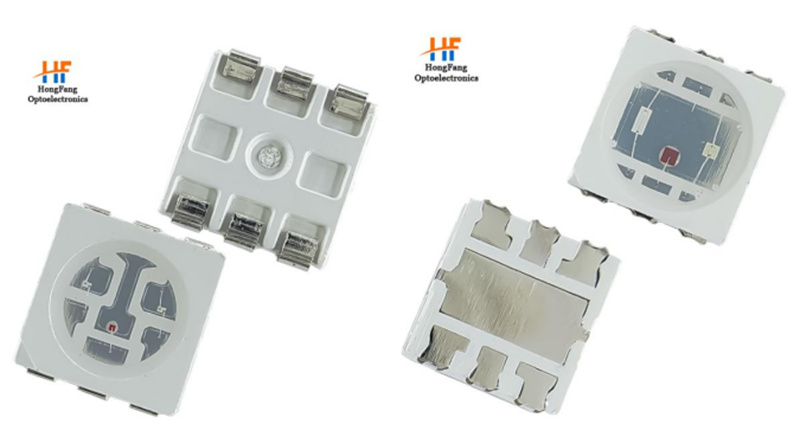
In the dynamic world of LED technology, selecting the right SMD (Surface Mounted Device) lamp beads is critical for optimizing performance in various lighting applications. Two popular choices—5050RGB and 5054RGB—offer distinct advantages tailored to specific needs. This article delves into their key differences and how they excel in different scenarios.
1. Power and Thermal Management: The Core Distinction
The most notable difference lies in their power capabilities and thermal design.
5050RGB LED Beads:
These feature a compact 5.0×5.0×1.7mm form factor with a tri-chip parallel design and six pins. While they can theoretically reach up to 0.6W, practical limitations restrict their maximum power to 0.3W, with 0.2W being the industry standard. Their thermal performance is constrained by traditional bracket structures, making them better suited for low-heat environments.
5054RGB LED Beads:
Engineered to address 5050’s power limitations, 5054RGB beads adopt a 5.0×5.4×1.6mm design with a built-in heat sink on the bonding pad. This innovation allows them to handle up to 1.5W, significantly enhancing thermal dissipation and reducing light decay. The result? Brighter output and reliability in high-power settings.
2. Application Scenarios: Tailored for Specific Environments
The divergence in power and thermal efficiency translates into distinct application landscapes.
5050RGB: Ideal for Indoor and Decorative Use
Commercial Lighting: Soft and hard light strips, linear lights, and illuminated signs leverage 5050RGB’s energy efficiency and compact size.
Decorative Solutions: Its low profile and uniform light distribution make it perfect for architectural accents, automotive interiors, and backlighting in consumer electronics.
Specialized Fields: Beauty equipment (e.g., multi-spectrum facial lamps) and plant growth systems benefit from its precise color mixing.
5054RGB: Dominating High-Power and Outdoor Settings
Commercial and Industrial Lighting: High-output fixtures like smart bulbs, floodlights, and street lamps rely on 5054RGB’s robust performance.
Outdoor Lighting: Stadiums, urban landscapes, and building facades use 5054RGB for vibrant, durable lighting solutions.
Advanced Systems: Home automation devices (e.g., color-changing smart lights) and professional photography tools (e.g., adjustable RGBW studio lights) exploit its superior thermal stability and color control.
3. Design and Compatibility Considerations
While both beads share a 5.0mm width, their structural differences impact usability
Pin Configuration:
5050RGB uses a common anode configuration, while 5054RGB employs separate anode, cathode, and ground pins. This means they cannot be directly interchanged without circuit adjustments.
Light Angle:
Both offer a 120° beam angle, but 5054RGB’s single-chip design ensures consistent color uniformity, crucial for professional lighting setups.
4. Emerging Trends and Future Potential
RGBW Integration: 5054RGBW variants are gaining traction in applications requiring precise white balance, such as photography and architectural lighting.
Sustainability: Both beads align with eco-friendly trends, with 5054RGB’s efficiency reducing energy costs in large-scale projects.
Conclusion: Choose Wisely for Optimal Results
5050RGB and 5054RGB LED beads serve unique purposes. While 5050RGB excels in cost-effective, low-power scenarios, 5054RGB dominates where high brightness and durability are essential. By understanding their thermal, structural, and application-specific strengths, designers and engineers can make informed choices to meet project requirements efficiently.
For further insights into LED technology, explore our latest product innovations and industry trends.









